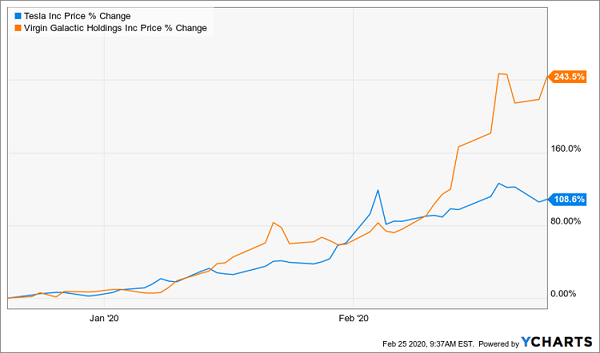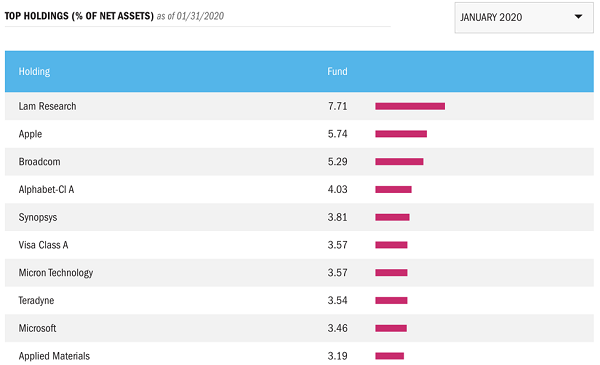Flipping through my stock screener earlier this week, I ran across two of the best examples of bubbles-in-the-making I’ve ever seen:
Looking to Lose Money? Invest Here.

Those would be Tesla (TSLA), in blue above, and Virgin Galactic (SPCE), in orange.
Bubbles, of course, are nothing new: Nobel Prize–winning economist Robert Shiller explained them in his 2000 book, aptly titled Irrational Exuberance:
“Errors of human judgment can infect even the smartest people, thanks to overconfidence, lack of attention to details and excessive trust in the judgments of others, stemming from a failure to understand that others are not making independent judgments but are themselves following still others—the blind leading the blind.”
Both are run by charismatic billionaires who are selling a promise of a better future to investors today.
Whether you believe in their vision or not, it’s undeniable that a stock doubling (or in Virgin Galactic’s case, tripling) in less than two months is a bubble—one that will eventually get popped.
But don’t expect these bubbles to pop immediately. Again, to quote Professor Shiller:
“The word ‘bubble’ creates a mental picture of an expanding soap bubble, which is destined to pop suddenly and irrevocably. But speculative bubbles are not so easily ended; indeed, they may deflate somewhat, as the story changes, then reflate.”
This is where the bubble metaphor confuses people: a bubble bursts and ceases to exist, but in the dot-com and housing bubbles, we didn’t see tech stocks or houses suddenly cease to exist. They reset at a lower value, which is likely to happen to Tesla and Virgin Galactic.
For aggressive traders who want to play this volatility for a profit, the rise and fall of firms like these is an opportunity, but not everyone wants the headaches and risks of finding entry and exit points for these companies. And if you’re looking at retirement within the next decade, the risks of these speculative assets are so high that they far outweigh any potential gains.
There’s a better way: the diversified income portfolio.
Building an Income Machine
Instead of speculating, we want to carefully build a portfolio of stocks that will go up steadily over time while also providing income we can use to reinvest, cover our daily needs, or both. There’s a proven way to accomplish this (which will come as no surprise to my CEF Insider subscribers): closed-end funds (CEFs) that invest in stocks with huge growth potential that also give you a large part of your return as dividends. (As I write, the average CEF yields around 7%, and many pay much more.)
Two great examples: tech-focused CEFs Liberty All-Star Growth Fund (ASG) and Columbia Seligman Premium Tech Growth Fund (STK). Here are three quick reasons why you’d want to choose them.
1.The Dividends
Most obviously, ASG and STK are compelling because of their yields. ASG pays 8%, and STK pays 7.5%; these are over 4 times the yields you’d get from an index fund! That means cash in your hand as you hold these funds, so you can choose to reinvest if you think stocks are cheap or pocket the money if you think the market is overvalued.
2. Outperformance
ASG and STK don’t just pay big dividends. They also crush the S&P 500, represented below by the popular index fund SPDR S&P 500 ETF (SPY), in blue.
Far Ahead of the Index

3. Disciplined Growth Portfolios
-
- The key to ASG and STK’s outperformance is their holdings. Both of these funds focus on tech-growth companies, but they do so in a tactical and disciplined manner.
STK: A Potent Mix of “Old” and “New” Tech

Source: Columbia Threadneedle
While STK’s portfolio, shown here, is heavy on high-flyers like Lam Research (LAM) and Teradyne (TER), it’s also got a cross-selection of mega-cap tech stocks with overflowing cash coming in from huge businesses, such as Microsoft (MSFT), Google (GOOGL), a.k.a. Alphabet, Visa (V) and Apple (AAPL).
Now let’s take a look at ASG’s top holdings:
ASG: Another Conservative-Growth Play

Source: All-Star Funds
Similarly, ASG’s portfolio combines Microsoft, Google and Visa with aggressive-growth companies like Chegg (CHGG) and Salesforce (CRM), balancing the risks of riding the momentum wave with the security of getting massive companies with huge moats at the right price.
These are both strong tech funds to buy now—much better options than speculating on companies like Tesla and Virgin Galactic, whose peaks and valleys are only visible in hindsight.
— Michael Foster
Your Safest Play Now: 4 Urgent Buys for 8.4% Dividends and Upside [sponsor]
With coronavirus fears running rampant these days, avoiding obvious traps like Tesla and Virgin Galactic might be the least of your worries. You want to know how to protect and grow your nest egg—and dividend stream!—now.
I’ve got 4 high-yield CEF picks that will help you do just that. Taken together, they yield a steady 8.4% today, so you’re already getting a big chunk of your yearly return in CASH, not flighty paper gains.
That’s just one layer of safety these 4 stalwart picks give you.
There’s another: the fact that each one trades at a totally ridiculous discount to net asset value (NAV, or the value of the assets in their portfolios)—a discount that’s only gotten sweeter thanks to the recent selloff.
So what can we expect in terms of upside here?
I’m calling for 20%+ price gains from each of these 4 picks—in addition to their outsized yields. And even if the market falls from here, these 4 funds’ big discounts mean they should easily be able to hold their own. And we’ll still collect their outsized payouts!
It’s the closest thing to a heads-you-win-tails-you-win situation I’ve seen in investing.
Full details on these 4 incredible funds are waiting for you now. Click right here and I’ll give you everything you need to know about all 4 of them: names, tickers, complete dividend histories, my unvarnished take on management—the works!
Source: Contrarian Outlook

